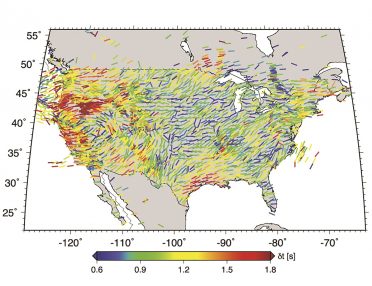Parts of Mantle Stuck to Plate
November 13, 2019

The North American plate is a medley of geological parts that protrude into Earth’s mantle like tree branches frozen into the surface of an iced-over lake. Research from the Jackson School of Geosciences has proposed a new method to map these “frozen-in” layers of the tectonic plate and reveal how it interacts with the upper mantle.
The study, which was published in May 2019 in Earth and Planetary Science Letters, is the first scientific paper from Wanying Wang, a graduate research assistant at the University of Texas Institute for Geophysics and doctoral candidate at the Jackson School of Geosciences. Wang said her work is important because it describes the fundamental rules that govern the Earth’s internal dynamics and will help scientists better understand the tectonic processes that have shaped North America.
“If you want to understand basic plate tectonics, it is important to understand how mantle dynamics and the lithosphere work together,” Wang said.
The paper focuses on a property of the Earth’s interior called seismic anisotropy. This property gives the upper mantle, when imaged with seismic waves, a certain “grain” that reveals the mantle’s internal flow. The grain is determined by the alignment of a mineral called olivine. The details of how olivine aligns in the mantle were explored in early laboratory work by Jackson School research engineer James Buttles. Wang and co-author Thorsten Becker, a Jackson School professor, tested several computer simulations of mantle flow and found a match with observations from USArray, a massive cross-continental effort to map the interior of the Earth beneath North America, but only when their models included a previously theorized frozen-in layer of old mantle.
“This is important because this layer contains information about past tectonic events and interactions between lithosphere and upper mantle,” Wang said.
According to the paper, the bottom of the North American plate is like the underside of a frozen lake with remnants from the mantle — some new, some ancient — cemented into the lithosphere. Frozen into these remnants are mineral “branches” carrying information about ancient tectonic events.
Wang said that although this frozen-in layer had been theorized and partly studied before, this is the first time it has been demonstrated on a continental scale using models of the upper mantle. By matching their models with observations, their work also supports existing theories about the geological evolution of the North American plate.
Back to the Newsletter